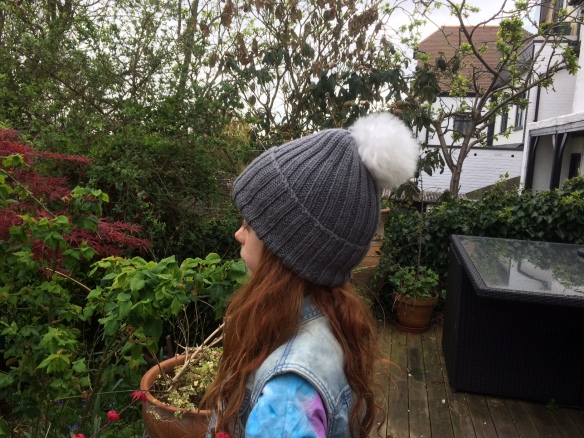Hello!
I haven’t been able to knit much over the last couple of weeks as I have been away at my daughter’s. Before I went, though, I managed to finish a poncho for my two granddaughters, or ‘Princess Cape’ as the four year-old calls it, and a simple, Urban Hat for Niamh, the elder girl. This is the second of these hats I have made for her: one has a pompom, and one does not. When I made the first one, neither my daughter, nor my granddaughter could decide whether they wanted a pompom or not, so my daughter decided that I could make two hats. She is not a knitter. More about the hat, shortly.

Urban Hat
Materials: 100g Aran or Worsted weight yarn
I used Debbie Bliss BFL Aran in Gunmetal (100% BFL wool)
Or: Debbie Bliss Cashmerino Aran
Rowan Wool Worsted
Sublime Aran
4.5mm 40cm circular needles, or double pointed needles; one long (at least 100cm) 4.5mm circular needle if using Magic Loop; a second 40cm circular needle if using two circulars for the crown.
Tension: 26sts and 26 rows to 10cm (4ins) in k2, p2 rib
Size: One size but see information below about changing the size
The hat will look very narrow while knitting because of the ribbing, but k2, p2 is a very stretchy stitch and a hat that measures about 40cm (14ins) unstretched will easily fit a head measuring 55cm (22ins).
I knitted this hat for a girl with lots of hair and her head measured 53cm (21ins). If I was making this for me, I would add an extra 8 stitches to the total, and for a man with a large head, an extra 12 stitches. The pattern repeat is 4 stitches, so just ensure the total number of stitches cast on is divisible by four. If you wish to make a smaller hat, cast on fewer stitches by deducting multiples of four.
Level of Difficulty: Suitable for knitters who can knit in the round; can work a simple k2 tog decrease; can work k2, p2 ribbing
Instructions
Using 4.5mm needle of your choice, (see above), cast on 92 sts.
Ensuring sts are not twisted, join to work in the round, placing a marker to denote the beginning of the round.
Round 1 and every round:* k2, p2, rep from * to end.
Rep this round until hat measures 26cm (10.5ins) from cast on edge.
Note: You may wish to change this measurement so the hat is suitable for its recipient. Measure from the base of the ear to the top of the crown, e.g. the measurement for my model was 19cm (7.5ins), then add on the amount of turn up desired on the cuff of the hat. I added on 9cm (3.5ins). For an adult, you may wish to work 10-12cm (4-4.5ins) for the turn up. So, if I was knitting this hat for me, I would probably knit 30cm (12ins) in rib.
Crown shaping: Change to dpns or two circulars as sts dec to make the knitting easier.
Round 1: * k2, p2tog, rep from * around
Rounds 2 &3: *k2, p1, rep from * around
Round 4: *k2tog, p1, rep from * around
Round 5: *K1, p1, rep from * around
Round 6: *k2tog, rep from * around
Round 7: Knit
Round 8: *k2tog, rep from * around
Round 9: Knit
Round 10: *k2tog, rep from * around
Round 11: Knit
Round 12: *k2tog, rep from * around. 6sts remain.
Break yarn, leaving a 20cm (8ins) tail. Thread yarn through remaining sts and finish off on inside of hat. Weave in ends.
I washed the hat in Eucalan, wrapped it up in a towel and squeezed hard to remove the excess water. I then laid the hat out on a mat or towel, smoothed out the stitches gently, and placed some empty kitchen roll holders inside the hat to avoid creating fold lines as the hat dried. There is no need to pin or stretch the hat, just a gentle smooth with the hands. Enjoy!
Add a pompom if desired. There are some lovely pure Alpaca ones available at the moment, if a little pricey. Or you can make your own, either using a pompom maker, or the old-fashioned method with cardboard.
Abbreviations
K knit
P purl
K2tog knit two together
rep repeat
sts stitches
dec decrease
dpns double pointed needles
I hope you enjoy the hat pattern. If you have any questions about it, please do not hesitate to contact me via the Stash contact form.
If you have any questions about the poncho, or would like to see it as a pattern, please contact me.
As ever, knit on.
Lesley
Copyright, Lesley Conroy 2016







